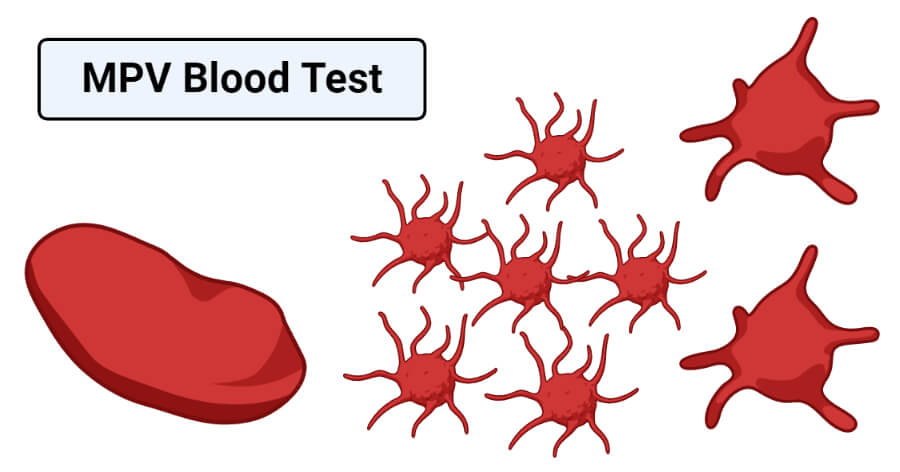Interesting Science Videos
What is MPV Blood Test?
MPV (Mean Platelet Volume) test is a test performed to determine the average size of platelets present in a blood sample.
- Platelets are important blood cells that are responsible for blood clotting, a process that controls blood loss after an injury.
- The mean platelet volume (MPV) is the measurement of the dimension of platelets, calculated by hematological analyzers depending on the volume distribution during routine blood morphology test.
- MPV blood test is performed as a part of the Complete Blood Count (CBC) which is a comprehensive test for the complete analysis of blood.
- MPV test is essential as the average size of platelets is larger when the body is producing large amounts of platelets, which, in turn, provides inferences regarding platelet formation and destruction.
- MPV test is not performed as a diagnostic test for certain diseases; instead, the test is performed as an overall general body check-up process.
- The test is closely related to the platelet count test that measures the total number of platelets present in the blood sample.
- The results of MPV tests might not mean much on their own, but the result interpretation should only be made with the context of other CBC tests.
- The normal value of MPV ranges between 7.5 to 12 fl (femtolitre), whereas the percentage of large platelets usually amount to 0.2-5.0% of the whole platelet population.

Calculation of MPV value
- MPV levels are calculated as a part of the CBC that is generally performed for the analysis of blood.
- MPV values are calculated by dividing the total mass of the platelets (plateletcrit) by the total number of platelets in a blood sample.
- In physiological conditions, MPV value is inversely proportional to the platelet count, which is associated with the maintenance of homeostasis and preservation of constant platelet mass.
Result Interpretation of MPV Blood Test
- The average or normal value of MPV in humans remains at about 7.5 to 12 fl.
- Abnormally high or low values might indicate different forms of diseases or disorders present in the body of the particular individual.
- In the case of results with higher or lower values of MPV, further investigations may be warranted.
- Abnormal results are not necessarily considered indications of severe health issues; however, in some cases, these might be significant, so it is important to rule them out.
- Based on the inverse relationship between MPV and the total platelet count, a reduction in their mean volume is accompanied by increased production of platelets.
- In various pathological conditions, the physiological proportion between MPV and platelet count is disturbed, which helps in the diagnosis of some such pathological conditions.
- Depending on the lifestyle of an individual, a low or high MPV value might still be completely normal. Thus, an interpretation should only be made once all the CBC test is performed.
High MPV value
- An MPV value is considered higher than normal when the value is above 12 fl. This indicates that the average size of the platelets is larger than the average.
- However, the result of the MPV test cannot be interpreted alone. It should be accompanied by the total platelet count.
- If the value of MPV is high and the total platelet count is low, it indicates that the bone marrow is rapidly producing platelets.
- New and young platelets are mostly larger and recently released from the bone marrow, whereas the older ones are smaller and circulate through the bloodstream.
- A higher value of MPV thus might indicate that older platelets are being destroyed, which is why more platelets are being produced in the bone marrow.
- Since the increased value of MPV correlates with platelet activation, it might also be a possible cause of some forms of cancer which results in platelet activation.
- Besides, a higher MPV value might also be indicative of other forms of diseases like heart diseases, hypothyroidism, stroke, or high blood pressure.
Low MPV value
- MPV value that is less than 7.5 fl is considered a low MPV value. This indicates that the size of the average size of the platelets is smaller than normal.
- Since older platelets tend to be smaller, a low MPV value might indicate that the bone marrow is not producing sufficient platelets.
- However, the low value of MPV on its own doesn’t mean anything. It thus should always be accompanied by the total platelet count.
- In some cases, low MPV value is seen in patients undergoing chemotherapy as they are injected with cytotoxic medications which cause a decrease in the number of platelets.
- Besides, other forms of diseases like inflammatory bowel disease and aplastic anemia might also be the possible cause behind this.
References and Sources
- Aleksandra Korniluk, Olga Martyna Koper-Lenkiewicz, Joanna Kamińska, Halina Kemona, Violetta Dymicka-Piekarska, “Mean Platelet Volume (MPV): New Perspectives for an Old Marker in the Course and Prognosis of Inflammatory Conditions”, Mediators of Inflammation, vol. 2019. https://doi.org/10.1155/2019/9213074
- 5% – https://www.hindawi.com/journals/mi/2019/9213074/
- 3% – https://www.healthline.com/health/mpv-test
- 2% – http://ddxhub.com/1_2_10_mean.htm
- 1% – https://www.researchgate.net/publication/221891888_Are_platelet_indices_of_clinical_use_A_multidisciplinary_review
- 1% – https://www.flashcardmachine.com/values.html
- 1% – https://www.emedicinehealth.com/complete_blood_count_cbc/article_em.htm
- 1% – https://www.answers.com/Q/Which_type_of_blood_cell_helps_in_the_clotting_of_blood
- 1% – https://medlineplus.gov/lab-tests/mpv-blood-test/
- 1% – https://en.islcollective.com/english-esl-worksheets/search/Diagnostic+Test
- 1% – http://njmr.in/uploads/3-2_162-165.pdf
- 1% – http://diseaseslist.org/mpv-blood-test-high-low-normal/
- <1% – https://healthjade.net/platelet-count/
- <1% – https://ehealthhall.com/mpv-blood-test.html
